Java Annotation认知(包括框架图、详细介绍、示例说明) (转)
Java Annotation是JDK5.0引入的一种注释机制。
网上很多关于Java Annotation的文章,看得人眼花缭乱。Java Annotation本来很简单的,结果说的人没说清楚;弄的看的人更加迷糊。
我按照自己的思路,对Annotation进行了整理。理解 Annotation 的关键,是理解Annotation的语法和用法,对这些内容,我都进行了详细说明;理解Annotation的语法和用法之后,再看Annotation的框架图,可能有更深刻体会。废话就说这么多,下面开始对Annotation进行说明。若您发现文章中存在错误或不足的地方,希望您能指出!
目录
第1部分 Annotation架构
第2部分 Annotation组成部分
第3部分 java自带的Annotation
第4部分 Annotation 的作用
第1部分 Annotation架构
先看看Annotation的架构图:
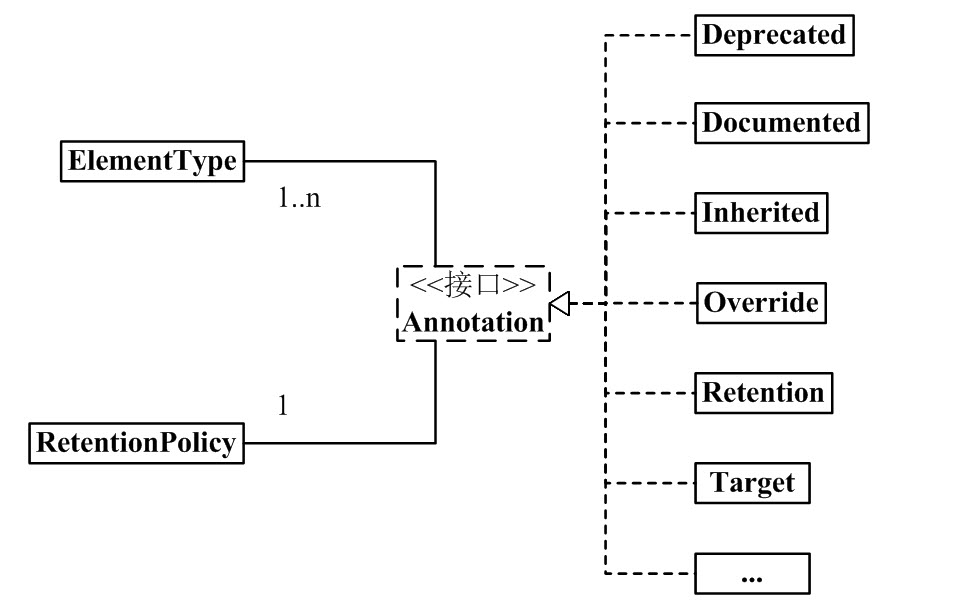
从中,我们可以看出:
(01) 1个Annotation 和 1个RetentionPolicy关联。
可以理解为:每1个Annotation对象,都会有唯一的RetentionPolicy属性。
(02) 1个Annotation 和 1~n个ElementType关联。
可以理解为:对于每1个Annotation对象,可以有若干个ElementType属性。
(03) Annotation 有许多实现类,包括:Deprecated, Documented, Inherited, Override等等。
Annotation 的每一个实现类,都“和1个RetentionPolicy关联”并且“和1~n个ElementType关联”。
下面,我先介绍框架图的左半边(如下图),即Annotation, RetentionPolicy, ElementType;然后在就Annotation的实现类进行举例说明。
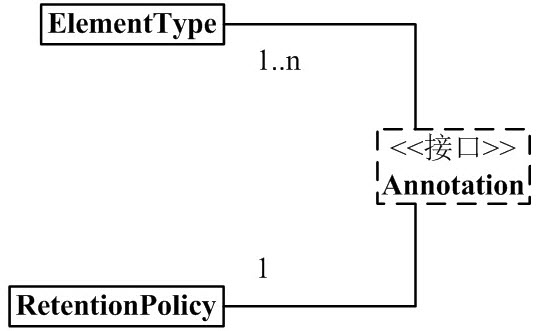
第2部分 Annotation组成部分
1. annotation组成成分
java annotation 的组成中,有3个非常重要的主干类。它们分别是:
(01) Annotation.java
- package java.lang.annotation;
- public interface Annotation {
-
- boolean equals (Object obj);
-
- int hashCode ();
-
- String toString ();
-
- Class<? extends Annotation> annotationType();
- }
(02) ElementType.java
- package java.lang. annotation;
-
- public enum ElementType {
- TYPE, /* 类、接口(包括注释类型)或枚举声明 */
-
- FIELD, /* 字段声明(包括枚举常量) */
-
- METHOD,/* 方法声明 */
-
- PARAMETER, /* 参数声明 */
-
- CONSTRUCTOR, /* 构造方法声明 */
-
- LOCAL_VARIABLE, /* 局部变量声明 */
-
- ANNOTATION_TYPE, /* 注释类型声明 */
-
- PACKAGE/* 包声明 */
- }
(03) RetentionPolicy.java
- package java.lang. annotation;
- public enum RetentionPolicy {
- SOURCE, /* Annotation信息仅存在于编译器处理期间,编译器处理完之后就没有该Annotation信息了 */
-
- CLASS,/* 编译器将Annotation存储于类对应的.class文件中。默认行为 */
-
- RUNTIME /* 编译器将Annotation存储于class文件中,并且可由JVM读入 */
- }
说明:
(01) Annotation 就是个接口。
“每1个Annotation” 都与 “1个RetentionPolicy”关联,并且与 “1~n个ElementType”关联。可以通俗的理解为:每1个Annotation对象,都会有唯一的RetentionPolicy属性;至于ElementType属性,则有1~n个。
(02) ElementType 是Enum枚举类型,它用来指定Annotation的类型。
“每1个Annotation” 都与 “1~n个ElementType”关联。当Annotation与某个ElementType关联时,就意味着:Annotation有了某种用途。
例如,若一个Annotation对象是METHOD类型,则该Annotation只能用来修饰方法。
(03) RetentionPolicy 是Enum枚举类型,它用来指定Annotation的策略。通俗点说,就是不同RetentionPolicy类型的Annotation的作用域不同。
“每1个Annotation” 都与 “1个RetentionPolicy”关联。
a) 若Annotation的类型为 SOURCE,则意味着:Annotation仅存在于编译器处理期间,编译器处理完之后,该Annotation就没用了。
例如,“ @Override ”标志就是一个Annotation。当它修饰一个方法的时候,就意味着该方法覆盖父类的方法;并且在编译期间会进行语法检查!编译器处理完后,“@Override”就没有任何作用了。
b) 若Annotation的类型为 CLASS,则意味着:编译器将Annotation存储于类对应的.class文件中,它是Annotation的默认行为。
c) 若Annotation的类型为 RUNTIME,则意味着:编译器将Annotation存储于class文件中,并且可由JVM读入。
这时,只需要记住“每1个Annotation” 都与 “1个RetentionPolicy”关联,并且与 “1~n个ElementType”关联。学完后面的内容之后,再回头看这些内容,会更容易理解。
第3部分 java自带的Annotation
理解了上面的3个类的作用之后,我们接下来可以讲解Annotation实现类的语法定义了。
1 Annotation通用定义
- @Documented
- @Target(ElementType.TYPE)
- @Retention(RetentionPolicy.RUNTIME)
- public @interface MyAnnotation1 {
- }
说明:
上面的作用是定义一个Annotation,它的名字是MyAnnotation1。定义了MyAnnotation1之后,我们可以在代码中通过“@MyAnnotation1”来使用它。
其它的,@Documented, @Target, @Retention, @interface都是来修饰MyAnnotation1的。下面分别说说它们的含义:
(01) @interface
使用@interface定义注解时,意味着它实现了java.lang.annotation.Annotation接口,即该注解就是一个Annotation。
定义Annotation时,@interface是必须的。
注意:它和我们通常的implemented实现接口的方法不同。Annotation接口的实现细节都由编译器完成。通过@interface定义注解后,该注解不能继承其他的注解或接口。
(02) @Documented
类和方法的Annotation在缺省情况下是不出现在javadoc中的。如果使用@Documented修饰该Annotation,则表示它可以出现在javadoc中。
定义Annotation时,@Documented可有可无;若没有定义,则Annotation不会出现在javadoc中。
(03) @Target(ElementType.TYPE)
前面我们说过,ElementType 是Annotation的类型属性。而@Target的作用,就是来指定Annotation的类型属性。
@Target(ElementType.TYPE) 的意思就是指定该Annotation的类型是ElementType.TYPE。这就意味着,MyAnnotation1是来修饰“类、接口(包括注释类型)或枚举声明”的注解。
定义Annotation时,@Target可有可无。若有@Target,则该Annotation只能用于它所指定的地方;若没有@Target,则该Annotation可以用于任何地方。
(04) @Retention(RetentionPolicy.RUNTIME)
前面我们说过,RetentionPolicy 是Annotation的策略属性,而@Retention的作用,就是指定Annotation的策略属性。
@Retention(RetentionPolicy.RUNTIME) 的意思就是指定该Annotation的策略是RetentionPolicy.RUNTIME。这就意味着,编译器会将该Annotation信息保留在.class文件中,并且能被虚拟机读取。
定义Annotation时,@Retention可有可无。若没有@Retention,则默认是RetentionPolicy.CLASS。
2 java自带的Annotation
通过上面的示例,我们能理解:@interface用来声明Annotation,@Documented用来表示该Annotation是否会出现在javadoc中, @Target用来指定Annotation的类型,@Retention用来指定Annotation的策略。
理解这一点之后,我们就很容易理解java中自带的Annotation的实现类,即Annotation架构图的右半边。如下图:
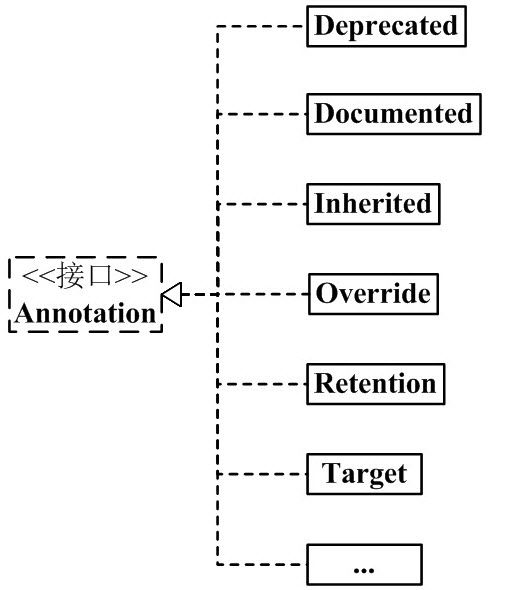
java 常用的Annotation:
| 标注 | 说明 |
|---|---|
| @Deprecated | @Deprecated 所标注内容,不再被建议使用。 |
| @Override | @Override 只能标注方法,表示该方法覆盖父类中的方法。 |
| @Documented | @Documented 所标注内容,可以出现在javadoc中。 |
| @Inherited | @Inherited只能被用来标注“Annotation类型”,它所标注的Annotation具有继承性。 |
| @Retention | @Retention只能被用来标注“Annotation类型”,而且它被用来指定Annotation的RetentionPolicy属性。 |
| @Target | @Target只能被用来标注“Annotation类型”,而且它被用来指定Annotation的ElementType属性。 |
| @SuppressWarnings | @SuppressWarnings 所标注内容产生的警告,编译器会对这些警告保持静默。 |
由于“@Deprecated和@Override”类似,“@Documented, @Inherited, @Retention, @Target”类似;下面,我们只对@Deprecated, @Inherited, @SuppressWarnings 这3个Annotation进行说明。
2.1 @Deprecated
@Deprecated 的定义如下:
- @Documented
- @Retention(RetentionPolicy.RUNTIME)
- public @interface Deprecated {
- }
说明:
(01) @interface -- 它的用来修饰Deprecated,意味着Deprecated实现了java.lang.annotation.Annotation接口;即Deprecated就是一个注解。
(02) @Documented -- 它的作用是说明该注解能出现在javadoc中。
(03) @Retention(RetentionPolicy.RUNTIME) -- 它的作用是指定Deprecated的策略是RetentionPolicy.RUNTIME。这就意味着,编译器会将Deprecated的信息保留在.class文件中,并且能被虚拟机读取。
(04) @Deprecated 所标注内容,不再被建议使用。
例如,若某个方法被 @Deprecated 标注,则该方法不再被建议使用。如果有开发人员试图使用或重写被@Deprecated标示的方法,编译器会给相应的提示信息。示例如下:
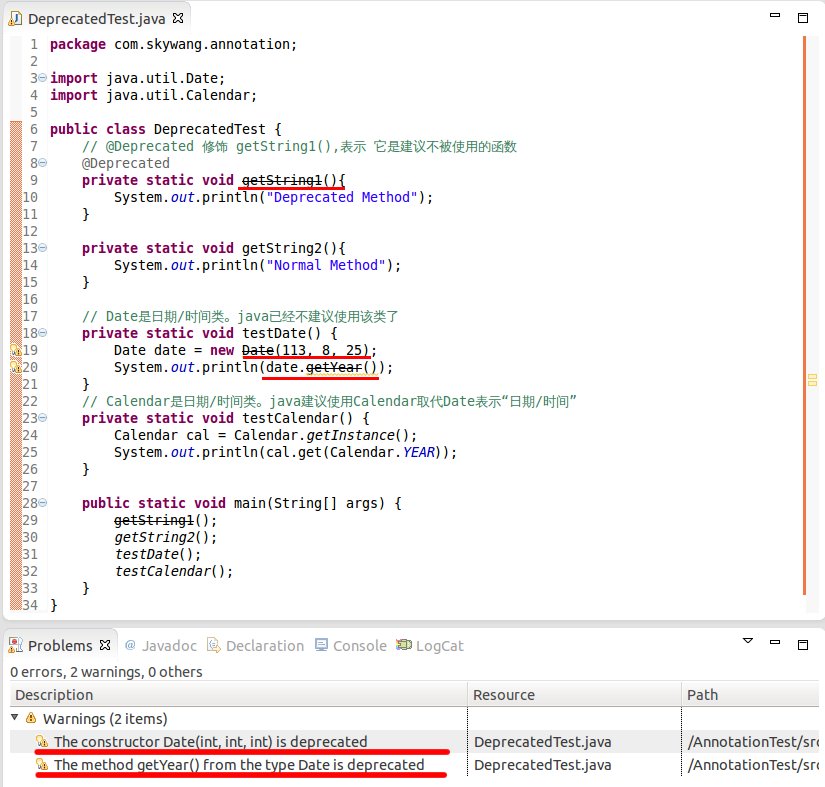
源码如下(DeprecatedTest.java):
- package com. skywang. annotation;
-
- import java. util. Date;
- import java. util. Calendar;
-
- public class DeprecatedTest {
- // @Deprecated 修饰 getString1(),表示 它是建议不被使用的函数
- @Deprecated
- private static void getString1( ){
- System. out. println( "Deprecated Method");
- }
-
- private static void getString2( ){
- System. out. println( "Normal Method");
- }
-
- // Date是日期/时间类。java已经不建议使用该类了
- private static void testDate( ) {
- Date date = new Date( 113, 8, 25);
- System. out. println(date. getYear());
- }
- // Calendar是日期/时间类。java建议使用Calendar取代Date表示“日期/时间”
- private static void testCalendar( ) {
- Calendar cal = Calendar. getInstance();
- System. out. println(cal. get( Calendar. YEAR));
- }
-
- public static void main( String[] args) {
- getString1();
- getString2();
- testDate();
- testCalendar();
- }
- }
说明:
上面是eclipse中的截图,比较类中 “getString1() 和 getString2()” 以及 “testDate() 和 testCalendar()” 。
(01) getString1() 被@Deprecated标注,意味着建议不再使用getString1();所以getString1()的定义和调用时,都会一横线。这一横线是eclipse()对@Deprecated方法的处理。
getString2() 没有被@Deprecated标注,它的显示正常。
(02) testDate() 调用了Date的相关方法,而java已经建议不再使用Date操作日期/时间。因此,在调用Date的API时,会产生警告信息,途中的warnings。
testCalendar() 调用了Calendar的API来操作日期/时间,java建议用Calendar取代Date。因此,操作Calendar不回产生warning。
2.2 @Inherited
@Inherited 的定义如下:
- @Documented
- @Retention(RetentionPolicy.RUNTIME)
- @Target(ElementType.ANNOTATION_TYPE)
- public @interface Inherited {
- }
说明:
(01) @interface -- 它的用来修饰Inherited,意味着Inherited实现了java.lang.annotation.Annotation接口;即Inherited就是一个注解。
(02) @Documented -- 它的作用是说明该注解能出现在javadoc中。
(03) @Retention(RetentionPolicy.RUNTIME) -- 它的作用是指定Inherited的策略是RetentionPolicy.RUNTIME。这就意味着,编译器会将Inherited的信息保留在.class文件中,并且能被虚拟机读取。
(04) @Target(ElementType.ANNOTATION_TYPE) -- 它的作用是指定Inherited的类型是ANNOTATION_TYPE。这就意味着,@Inherited只能被用来标注“Annotation类型”。
(05) @Inherited 的含义是,它所标注的Annotation将具有继承性。
假设,我们定义了某个Annotaion,它的名称是MyAnnotation,并且MyAnnotation被标注为@Inherited。现在,某个类Base使用了MyAnnotation,则Base具有了“具有了注解MyAnnotation”;现在,Sub继承了Base,由于MyAnnotation是@Inherited的(具有继承性),所以,Sub也“具有了注解MyAnnotation”。
@Inherited的使用示例
源码如下(InheritableSon.java):
- /
- * @Inherited 演示示例
- *
- * @author skywang
- * @email kuiwu-wang@163.com
- */
- package com.skywang.annotation;
-
- import java.lang.annotation.Target;
- import java.lang.annotation.ElementType;
- import java.lang.annotation.Retention;
- import java.lang.annotation.RetentionPolicy;
- import java.lang.annotation.Inherited;
-
- /
- * 自定义的Annotation。
- */
- @Target(ElementType.TYPE)
- @Retention(RetentionPolicy.RUNTIME)
- @Inherited
- @interface Inheritable
- {
- }
-
- @Inheritable
- class InheritableFather
- {
- public InheritableFather () {
- // InheritableBase是否具有 Inheritable Annotation
- System.out.println( "InheritableFather:"+InheritableFather.class.isAnnotationPresent(Inheritable.class));
- }
- }
-
- /
- * InheritableSon 类只是继承于 InheritableFather,
- */
- public class InheritableSon extends InheritableFather
- {
- public InheritableSon () {
- super(); // 调用父类的构造函数
- // InheritableSon类是否具有 Inheritable Annotation
- System.out.println( "InheritableSon:"+InheritableSon.class.isAnnotationPresent(Inheritable.class));
- }
-
- public static void main (String[] args)
- {
- InheritableSon is = new InheritableSon();
- }
- }
运行结果:
- InheritableFather: true
- InheritableSon: true
现在,我们对InheritableSon.java进行修改:注释掉“Inheritable的@Inherited注解”。
源码如下(InheritableSon.java):
- /
- * @Inherited 演示示例
- *
- * @author skywang
- * @email kuiwu-wang@163.com
- */
- package com.skywang.annotation;
-
- import java.lang.annotation.Target;
- import java.lang.annotation.ElementType;
- import java.lang.annotation.Retention;
- import java.lang.annotation.RetentionPolicy;
- import java.lang.annotation.Inherited;
-
- /
- * 自定义的Annotation。
- */
- @Target(ElementType.TYPE)
- @Retention(RetentionPolicy.RUNTIME)
- //@Inherited
- @interface Inheritable
- {
- }
-
- @Inheritable
- class InheritableFather
- {
- public InheritableFather () {
- // InheritableBase是否具有 Inheritable Annotation
- System.out.println( "InheritableFather:"+InheritableFather.class.isAnnotationPresent(Inheritable.class));
- }
- }
-
- /
- * InheritableSon 类只是继承于 InheritableFather,
- */
- public class InheritableSon extends InheritableFather
- {
- public InheritableSon () {
- super(); // 调用父类的构造函数
- // InheritableSon类是否具有 Inheritable Annotation
- System.out.println( "InheritableSon:"+InheritableSon.class.isAnnotationPresent(Inheritable.class));
- }
-
- public static void main (String[] args)
- {
- InheritableSon is = new InheritableSon();
- }
- }
运行结果:
- InheritableFather: true
- InheritableSon: false
对比上面的两个结果,我们发现:当注解Inheritable被@Inherited标注时,它具有继承性。否则,没有继承性。
2.3 @SuppressWarnings
@SuppressWarnings 的定义如下:
- @Target({TYPE, FIELD, METHOD, PARAMETER, CONSTRUCTOR, LOCAL_VARIABLE})
- @Retention(RetentionPolicy.SOURCE)
- public @interface SuppressWarnings {
- String[] value();
- }
说明:
(01) @interface -- 它的用来修饰SuppressWarnings,意味着SuppressWarnings实现了java.lang.annotation.Annotation接口;即SuppressWarnings就是一个注解。
(02) @Retention(RetentionPolicy.SOURCE) -- 它的作用是指定SuppressWarnings的策略是RetentionPolicy.SOURCE。这就意味着,SuppressWarnings信息仅存在于编译器处理期间,编译器处理完之后SuppressWarnings就没有作用了。
(03) @Target({TYPE, FIELD, METHOD, PARAMETER, CONSTRUCTOR, LOCAL_VARIABLE}) -- 它的作用是指定SuppressWarnings的类型同时包括TYPE, FIELD, METHOD, PARAMETER, CONSTRUCTOR, LOCAL_VARIABLE。
TYPE意味着,它能标注“类、接口(包括注释类型)或枚举声明”。
FIELD意味着,它能标注“字段声明”。
METHOD意味着,它能标注“方法”。
PARAMETER意味着,它能标注“参数”。
CONSTRUCTOR意味着,它能标注“构造方法”。
LOCAL_VARIABLE意味着,它能标注“局部变量”。
(04) String[] value(); 意味着,SuppressWarnings能指定参数
(05) SuppressWarnings 的作用是,让编译器对“它所标注的内容”的某些警告保持静默。例如,"@SuppressWarnings(value={"deprecation", "unchecked"})" 表示对“它所标注的内容”中的 “SuppressWarnings不再建议使用警告”和“未检查的转换时的警告”保持沉默。示例如下:
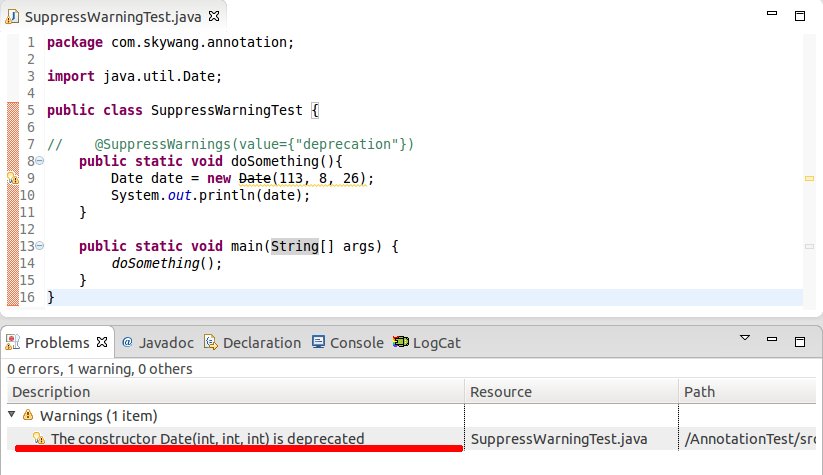
源码如下(SuppressWarningTest.java):
- package com. skywang. annotation;
-
- import java. util. Date;
-
- public class SuppressWarningTest {
-
- //@SuppressWarnings(value={"deprecation"})
- public static void doSomething( ){
- Date date = new Date( 113, 8, 26);
- System. out. println(date);
- }
-
- public static void main( String[] args) {
- doSomething();
- }
- }
说明:
(01) 左边的图中,没有使用 @SuppressWarnings(value={"deprecation"}) , 而Date属于java不再建议使用的类。因此,调用Date的API时,会产生警告。
而右边的图中,使用了 @SuppressWarnings(value={"deprecation"})。因此,编译器对“调用Date的API产生的警告”保持沉默。
补充:SuppressWarnings 常用的关键字的表格
| 关键字 | 说明 |
|---|---|
| deprecation | 使用了不赞成使用的类或方法时的警告 |
| unchecked | 执行了未检查的转换时的警告,例如当使用集合时没有用泛型 (Generics) 来指定集合保存的类型。 |
| fallthrough | 当 Switch 程序块直接通往下一种情况而没有 Break 时的警告。 |
| path | 在类路径、源文件路径等中有不存在的路径时的警告。 |
| serial | 当在可序列化的类上缺少 serialVersionUID 定义时的警告。 |
| finally | 任何 finally 子句不能正常完成时的警告。 |
| all | 关于以上所有情况的警告。 |
第4部分 Annotation 的作用
Annotation 是一个辅助类,它在Junit、Struts、Spring等工具框架中被广泛使用。
我们在编程中经常会使用到的Annotation作用有:
1 编译检查
Annotation具有“让编译器进行编译检查的作用”。
例如,@SuppressWarnings, @Deprecated和@Override都具有编译检查作用。
(01) 关于@SuppressWarnings和@Deprecated,已经在“第3部分”中详细介绍过了。这里就不再举例说明了。
(02) 若某个方法被 @Override的 标注,则意味着该方法会覆盖父类中的同名方法。如果有方法被@Override标示,但父类中却没有“被@Override标注”的同名方法,则编译器会报错。示例如下:
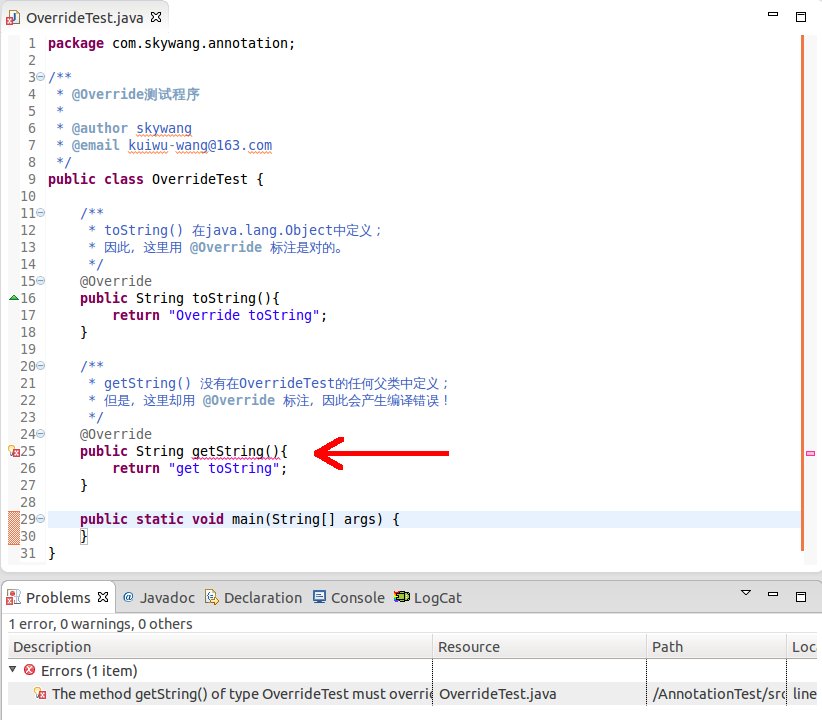
源码(OverrideTest.java):
- package com. skywang. annotation;
-
- /
- * @Override测试程序
- *
- * @author skywang
- * @email kuiwu-wang@163.com
- */
- public class OverrideTest {
-
- /
- * toString() 在java.lang.Object中定义;
- * 因此,这里用 @Override 标注是对的。
- */
- @Override
- public String toString( ){
- return "Override toString";
- }
-
- /
- * getString() 没有在OverrideTest的任何父类中定义;
- * 但是,这里却用 @Override 标注,因此会产生编译错误!
- */
- @Override
- public String getString( ){
- return "get toString";
- }
-
- public static void main( String[] args) {
- }
- }
上面是该程序在eclipse中的截图。从中,我们可以发现“getString()”函数会报错。这是因为“getString() 被@Override所标注,但在OverrideTest的任何父类中都没有定义getString1()函数”。
“将getString() 上面的@Override注释掉”,即可解决该错误。
2 在反射中使用Annotation
在反射的Class, Method, Field等函数中,有许多于Annotation相关的接口。
这也意味着,我们可以在反射中解析并使用Annotation。
源码如下(AnnotationTest.java):
- package com.skywang.annotation;
-
- import java.lang.annotation.Annotation;
- import java.lang.annotation.Target;
- import java.lang.annotation.ElementType;
- import java.lang.annotation.Retention;
- import java.lang.annotation.RetentionPolicy;
- import java.lang.annotation.Inherited;
- import java.lang.reflect.Method;
-
- /
- * Annotation在反射函数中的使用示例
- *
- * @author skywang
- * @email kuiwu-wang@163.com
- */
- @Retention(RetentionPolicy.RUNTIME)
- @interface MyAnnotation {
- String[] value() default "unknown";
- }
-
- /
- * Person类。它会使用MyAnnotation注解。
- */
- class Person {
-
- /
- * empty()方法同时被 "@Deprecated" 和 “@MyAnnotation(value={"a","b"})”所标注
- * (01) @Deprecated,意味着empty()方法,不再被建议使用
- * (02) @MyAnnotation, 意味着empty() 方法对应的MyAnnotation的value值是默认值"unknown"
- */
- @MyAnnotation
- @Deprecated
- public void empty (){
- System.out.println( "\nempty");
- }
-
- /
- * sombody() 被 @MyAnnotation(value={"girl","boy"}) 所标注,
- * @MyAnnotation(value={"girl","boy"}), 意味着MyAnnotation的value值是{"girl","boy"}
- */
- @MyAnnotation(value={"girl","boy"})
- public void somebody (String name, int age){
- System.out.println( "\nsomebody: "+name+ ", "+age);
- }
- }
-
- public class AnnotationTest {
-
- public static void main (String[] args) throws Exception {
-
- // 新建Person
- Person person = new Person();
- // 获取Person的Class实例
- Class c = Person.class;
- // 获取 somebody() 方法的Method实例
- Method mSomebody = c.getMethod( "somebody", new Class[]{String.class, int.class});
- // 执行该方法
- mSomebody.invoke(person, new Object[]{ "lily", 18});
- iteratorAnnotations(mSomebody);
-
-
- // 获取 somebody() 方法的Method实例
- Method mEmpty = c.getMethod( "empty", new Class[]{});
- // 执行该方法
- mEmpty.invoke(person, new Object[]{});
- iteratorAnnotations(mEmpty);
- }
-
- public static void iteratorAnnotations (Method method) {
-
- // 判断 somebody() 方法是否包含MyAnnotation注解
- if(method.isAnnotationPresent(MyAnnotation.class)){
- // 获取该方法的MyAnnotation注解实例
- MyAnnotation myAnnotation = method.getAnnotation(MyAnnotation.class);
- // 获取 myAnnotation的值,并打印出来
- String[] values = myAnnotation.value();
- for (String str:values)
- System.out.printf(str+ ", ");
- System.out.println();
- }
-
- // 获取方法上的所有注解,并打印出来
- Annotation[] annotations = method.getAnnotations();
- for(Annotation annotation : annotations){
- System.out.println(annotation);
- }
- }
- }
运行结果:
- somebody: lily, 18
- girl, boy,
- @com.skywang.annotation.MyAnnotation( value =[girl, boy])
-
- empty
- unknown,
- @com.skywang.annotation.MyAnnotation( value =[ unknown])
- @java.lang.Deprecated()
3 根据Annotation生成帮助文档
通过给Annotation注解加上@Documented标签,能使该Annotation标签出现在javadoc中。
4 能够帮忙查看查看代码
通过@Override, @Deprecated等,我们能很方便的了解程序的大致结构。
另外,我们也可以通过自定义Annotation来实现一些功能。
备注:原文链接,http://wangkuiwu.github.io/2012/03/03/annotation/
另外关于java注解和自定义注解处理器可以参考这篇文章:http://blog.csdn.net/haveferrair/article/details/52182927
转载于:https://www.cnblogs.com/hubavyn/p/8442320.html


